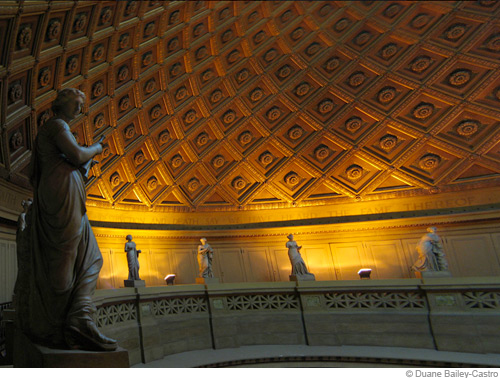Introduction

"Bronx Architecture" is an online guide to the architecture of the borough developed by Lehman College Art Gallery/CUNY. Designed as a companion to "Public Art in the Bronx," the Web site features over 100 buildings, background on architects, neighborhood walking tours, maps, lesson-plans for high school teachers, neighborhood histories, a resource section, and glossary. Like the Web site devoted to public art, we hope that this guide will provide a useful resource for the general public as well as teachers and encourage exploration of the art and architecture of the Bronx.
Susan Hoeltzel, Project Director
At the time of European contact in the 17th century, the Bronx was home to the Weckquaesgeek and Siwanoy, Algonquin speaking members of the Wappinger Confederation. Charted in 1609 by Henry Hudson, an English explorer sailing for the Dutch West India Company, the Bronx was first settled in 1639 - by Jonas Bronck, a Swedish sea captain from whom the name of the borough is derived. Today the earliest remaining architectural structures date to the 18th century - the Van Cortlandt Mansion, a Georgian manor built in 1748-49, is the oldest.
The architectural heritage of the Bronx is impressive with major projects by well-known designers, among them Stanford White, James Renwick, Jr., Heins and La Farge, Richard Morris Hunt, John Russell Pope, Marcel Breuer, Richard Meier, Paul Rudolph, Philip Johnson, and Rafael Viñoly. In addition to structures by well-known architects, the Web site includes buildings that played an important role in American history as well the life of the community - there are homes, apartment buildings, schools, and hospitals. It includes the Poe Cottage, the home of Edgar Allen Poe, who moved to the Bronx in 1846 in the hope that the country air would improve his wife's health, and the new Yankee Stadium, the recent incarnation of "the house that Ruth built. "
Among the borough's highlights are: the Grand Concourse, one of the great thoroughfares of the City known for its Art Deco/Art Moderne apartment buildings; Woodlawn Cemetery, with mausoleums designed by some of America's most respected architects; Gould Memorial Library and Hall of Fame Terrace by Stanford White, a memorial to Jay Gould that references the Pantheon; and the New York Botanical Garden whose original site was developed with the advice of Calvert Vaux and Samuel Parsons. The Web site also includes the Wildlife Conservation Society/ Bronx Zoo with its extraordinary Heins and La Farge buildings and a central courtyard that is a direct outgrowth of the City Beautiful movement and the World's Columbian Exposition of 1893. Paul Rudolph's Tracey Towers, a landmark visible from northern Manhattan to Westchester County, incorporates organic curves that make its towers look like futuristic sandcastles. The Kingsbridge Armory, a massive structure that suggests a medieval castle, is in the process of re-design for community use. In addition to the Van Cortlandt Mansion and Poe Cottage, a number of homes are now museums - Valentine-Varian House, a 1758 farmhouse, that houses the Bronx Historical Society; the Bartow-Pell Mansion Museum on Long Island Sound; and Wave Hill with its gardens and Hudson River views. Lehman College Art Gallery, developer of this Web site, is located in a building designed by Marcel Breuer in 1960.
This project has been developed with generous support from: National Endowment for the Humanities, National Endowment for the Arts, New York Council for the Humanities, New York State Council on the Arts, H.W. Wilson Foundation, Booth Ferris Foundation, The American Architectural Foundation, JPMorgan Chase Foundation, New York City Department of Cultural Affairs; the Bronx Delegation of the New York City Council; The Beth M. Uffner Arts Fund / The New York Community Trust, and Friends of the Lehman College Art Gallery.
In addition, the project has been designated a National Endowment for the Humanities "We the People" project and is being supported in part by funds the agency has set aside for this special initiative. The goal of the "We the People" initiative is to encourage and strengthen the teaching, study, and understanding of American history and culture through the support of projects that explore significant events and themes in our nation's history and that advance knowledge of the principles that define America.
Susan Hoeltzel
Bronx Architecture was developed by the Lehman College Art Gallery/CUNY. Susan Hoeltzel served as project director. Architectural descriptions were written by David Bady, Janet Butler Munch, and Lloyd Ultan. Elisabeth Lorin and Mary Ann Siano developed the biographical entries. Patricia Cazorla has been our web designer and developed the site with additional technical support from David Schwittek. Ideas for Teachers were written by the gallery’s education coordinator Sember Weinman. The Tours and Ideas for Teachers sections were designed by gallery educator Ali Irizarry. The Neighborhood section was written by David Bady. Photographers for the project were Tom Stoelker, Abigail McQuade, and Kareema Hussein. Hanuei Min provided additional web assistance in preparing photographs. Archival photographs are from the Lehman Library / CUNY Special Collections. Mary Ann Siano provided the development work that made this project possible. Susan Fleminger has served as the project evaluator. Additional technical support was provided by David Gillison, Bob Schneider, and David Stevens.